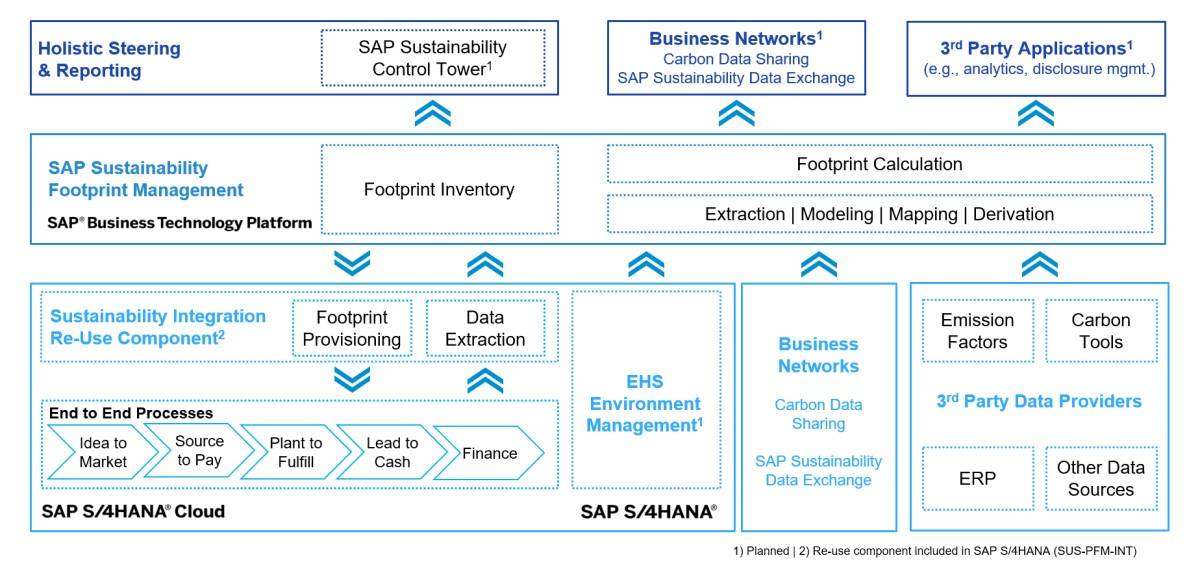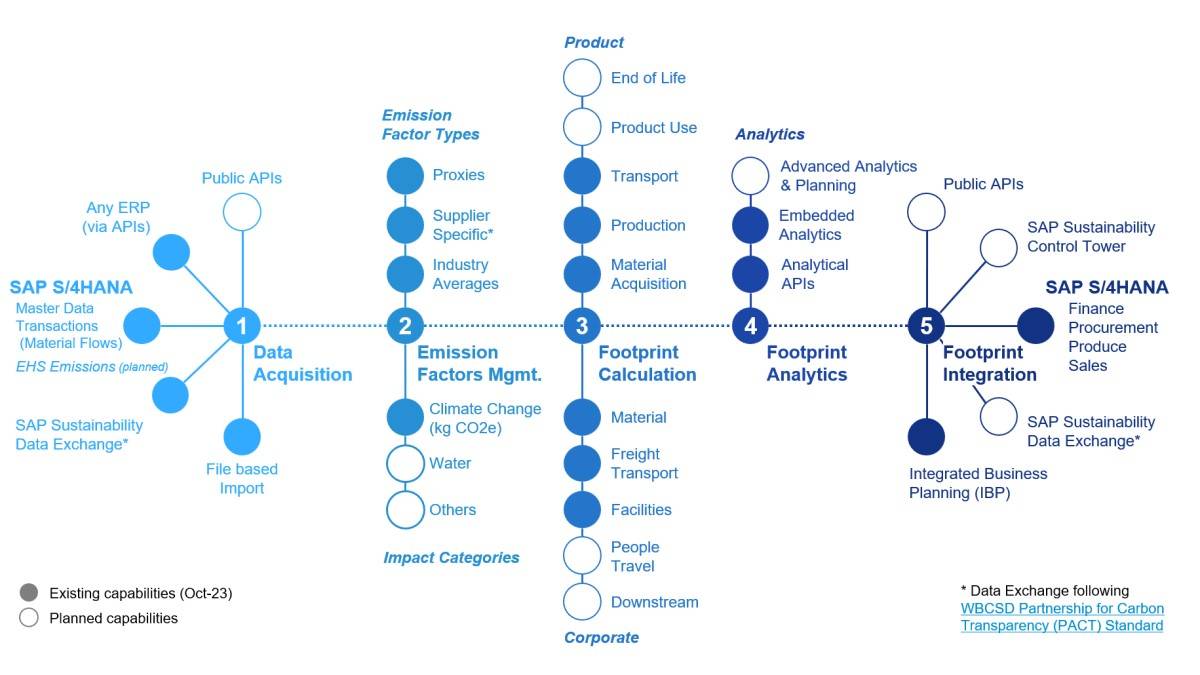In the face of climate change and its global impact, the issue of sustainability is increasingly becoming a critical factor for companies worldwide. There is a growing awareness that sustainable action is crucial for long-term economic viability and social acceptance. The software SAP Sustainability Footprint Management (SFM) enables companies to measure, monitor and proactively manage the greenhouse gas emissions and related environmental impacts of their business activities.
Want to establish effective sustainability reporting?
What is SAP Sustainability Footprint Management?
SAP Sustainability Footprint Management aims to provide companies with the tools they need to improve their climate protection performance. The software provides advanced capabilities for real-time measurement and analysis of climate-related data that can be used for corporate sustainability reporting and to optimize operations. In this way, SAP SFM facilitates the transparent presentation of an organization’s environmental and climate performance while ensuring that legal requirements and standards regarding climate protection are met.

SAP Sustainability Footprint Management can be seamlessly integrated with SAP S/4HANA and other ERP systems.
The central architecture module SAP SFM
At the heart of sustainable corporate management is SAP SFM, which acts as a central hub for environmental data and processes. Through integration with SAP S/4HANA, SAP SFM enables the seamless collection and processing of data to provide accurate carbon footprints. Within SAP SFM, modules such as the Footprint Inventory and the functions for extraction, modeling, mapping and derivation ensure that all steps from data collection to carbon footprint calculation are efficient and transparent. The ability to transfer calculated footprint results to SAP Sustainability Control Tower, business networks or third-party applications demonstrates the flexibility and openness of the system and allows for comprehensive environmental reporting and improved collaboration along the entire value chain.
The most important features of SAP SFM
Actual data instead of average values – SAP Sustainability Footprint Management paves the way for transactional carbon accounting. The various functionalities increase the speed, accuracy and effectiveness of emissions calculations. This creates a fact-based data foundation for companies to tackle the decarbonization of their entire value chain with targeted measures.

The features of SAP Sustainability Footprint Management at a glance
Data acquisition
With SAP Sustainability Footprint Management, companies can seamlessly integrate relevant data from various sources such as SAP S/4HANA on-premise, SAP S/4HANA Cloud and third-party systems. This includes both master data and transaction data. This provides a detailed picture of company-wide emissions and thus ensures accurate recording of the carbon footprint across all business processes.
Emission Factors Management
SAP SFM can import and manage emission factors from various sources such as supplier data or Life Cycle Assessment (LCA) databases. These factors are crucial to accurately determine the CO2-equivalent footprint (CO2e) of a company. In addition, SAP SFM makes it possible to automatically assign emission factors to business processes, further simplifying and improving the calculation of the carbon footprint.
Footprint Calculation
SAP SFM calculates the carbon footprint at both product and company level based on incoming business and emissions data. With options such as energy flow modeling and allocation rules, the tool provides a flexible and accurate carbon footprint calculation that is consistent and auditable. The calculation is performed along the entire value chain and enables companies to precisely quantify their environmental impact.
Footprint Analytics
The Footprint Analytics functionality of SAP SFM provides in-depth insights into the carbon footprint through embedded dashboards and analysis tools. Users can analyze data, identify trends and understand the source of emissions through detailed reports. The application also allows transport emissions to be analyzed comprehensively and displayed visually on a world map to identify emission hotspots.
Footprint Integration
The integration of the calculated carbon footprint into SAP S/4HANA and other business processes is seamless with SAP SFM. This integration enables companies to view sustainability metrics alongside traditional business metrics, allowing them to feed directly into purchasing and inventory management as well as supply chain and production process planning. In the future, SAP plans to further expand the integration to enable more comprehensive and transparent sustainability management.
How companies benefit from SAP SFM
SAP Sustainability Footprint Management calculates the carbon footprint at product and company level and considers the entire value chain across company boundaries. The use of SAP FSM is associated with a number of benefits for companies.
Improved sustainability performance
SAP SFM supports companies in making their sustainability performance transparent and allows a holistic view of the company’s environmental impact. This leads to a lasting establishment of environmentally friendly and socially responsible business practices.
Achieving competitive advantages
Companies that transparently present and optimize their ecological footprint stand out positively from their competitors. This strengthens their brand image and promotes the trust of customers, employees and investors.
Cost savings
By optimizing resources and processes, companies reduce their costs and can operate more sustainably at the same time. Standardized access to data, for example from SAP S/4HANA, drastically reduces costs compared to other providers or custom developments.
Risk reduction
SAP SFM enables companies to identify environmental risks along their supply chain and take measures to minimize these risks. This can help, for example, to comply with environmental standards and reduce emission volumes, which in turn reduces the risk of regulatory penalties and strengthens corporate resilience.
Global standards
The system supports companies in complying with internationally recognized sustainability standards and regulations such as the GHG Protocol, which can lead to easier market access, among other things.
Conclusion: Know and optimize your own carbon footprint
Calculating and disclosing the carbon footprint is essential for companies today. SAP Sustainability Footprint Management not only provides accurate carbon footprint calculation based on actual ERP data and energy flow modeling, but also enables deeper analysis and integration of sustainability data into business processes. With SAP SFM as an advanced carbon footprint calculation solution, companies can effectively pursue their sustainability goals and ensure their competitiveness in an increasingly environmentally conscious business world.
![IBacademy_Logo_blau[496] IBacademy_Logo_blau[496]](https://www.ibsolution.com/hs-fs/hubfs/IBacademy_Logo_blau%5B496%5D.jpg?width=200&name=IBacademy_Logo_blau%5B496%5D.jpg)




